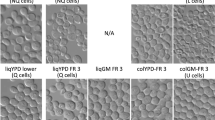Abstract
A method of the fractionation of aSaccharomyces cerevisiae yeast population in dextran gradients is described. The elaboration of this method was based on the finding of a correlation between the size of individual cells and the number of bud scars on their surface and rapid indication of the scars by fluorescence microscopy. The basic conditions for fractionation (determined experimentally) were as follows: 2 ml. yeast suspension (100 mg. dry weight) was applied to the surface of a continuous dextran gradient of 9–16% concentration and was centrifuged at a relative centrifugal force of 200 G for 15 minutes. In fractionation of a whole population, the best fractionation was obtained in a linear gradient. Repeated separation of fractions obtained by centrifugation in a linear gradient in a concave gradient further separated cells without bud scars and accumulated cells with five scars and over. Three fractions were obtained by this technique. The first contained 90–98% cells without bud scars, the second 55–65% cells with 1–4 bud scars and the third 50% cells with five bud scars and over.
Abstract
Описан метод фракционирования популяции дрожжей Saccharomyces cerevisiae в декстрановых градиентах. Основной предпосылкой для разработки этого метода было обнаружение отношения между размерами отдельных клеток и количеством материнских шрамов на их поверхности, а также способ быстрой индикации шрамов с помощью флуоресцентной микроскопии. Экспериментально были установлены следующие основные условия для фракционирования: суспензию дрожжей (100 мг сухого вещества) в 2 мл вносили в горизонт декстрана с концентрацией, постепенно и непрерывно повышающейся от 9 до 16%, и центрифугировали 15 мин. при относительной центробежной силе 200 G. При центрифугировании всей популяции наиболее успешное фракционирование было получено в линейном градиенте. Путем дальнейшего разделения фракций, полученных в резулятате центрифугирования в линейном градиенте, с применением вогнутого градиента удалось отделить еще клетки без материнских шрамов и скопления клеток с 5 и более шрамами. Так были получены 3 фракции: первая содержала 90–98% клеток без материнских шрамов, вторая— 55–65% клеток c 1–4 материнскими шрамами, а третья—50% клеток с 5 и более материнскими шрамами.
Similar content being viewed by others
References
Abbo, F. R., Pardee, A. B.:Synthesis of macromolecules in synchronously dividing bacteria. Biochim. biophys. Acta 39: 478, 1960.
Albertsson, P. A.:Partition of cell particles and macromolecules. J. Wiley, New York, 1960.
Albertsson, P. A.:Partition methods for fractionation of cell particles and macromolecules. In: Methods of Biochemical Analysis. D. Glick ed., Vol. 10, p. 229. Interscience Publishers, New York, 1962.
Albertsson, P. A., Baird, G. D.:Counter-current distribution of cells. Exp. Cell Res. 28: 296, 1962.
Anderson, N. G.:Techniques for the mass isolation of cellular components. In: Physical Techniques in Biological Research. G. Oster, A. W. Pollister ed., Vol. III. Cells and tissues, p. 299. Academic Press, New York, 1956.
Barton, A. A.:Some aspects of cell division in Saccharomyces cerevisiae. J. Gen. Microbiol. 4: 84, 1950.
Britten, R. J., Roberts, R. B.:High-resolution density gradient sedimentation analysis. Science 131: 32, 1960.
Kocková-Kratochvílová, A:Praktikum technické mikrobiologie. Prague, 1954.
Maruyama, Y., Yanagita, T.:Physical methods for obtaining synchronous culture of E. coli. J. Bacteriol. 71: 542, 1956.
Mikeš, O.et al.:Přírucčka laboratorních chromatografických metod, 264. SNTL, Prague, 1961.
Nosoh, Y., Takamiya, A.:Synchronisation of budding cycle in yeast cells and effect of carbon monoxide and nitrogen deficiency on the synchrony. Plant Cell Physiol. 3: 53, 1962.
Olson, B. H., Johnson, M. J.:Factors producing high yeast yields in synthetic media. J. Bacteriol. 57: 235, 1949.
Streiblová, E., Beran, K.:Demonstration of yeast scars by fluorescence microscopy. Exp. Cell Res. 30: 603, 1963a.
Streiblová, E., Beran, K.:Types of multiplication scars in yeast, demonstrated by fluorescence microscopy. Fol. microbiol. 8: 221, 1963b.
Williamson, D. H., Scopes, A. W.:The behaviour of nucleic acid in synchronously dividing cultures of Saccharomyces cerevisiae. Exp. Cell Res. 20: 338, 1960.
Zviagintsev, D. G.:Some laws of the adsorption of microorganisms to ion exchange resins. Mikrobiologiya 31: 339, 1962 (Звиягинцев, Д. Г.: Микробиология 31: 339, 1962).
Author information
Authors and Affiliations
Rights and permissions
About this article
Cite this article
Lieblová, J., Beran, K. & Streiblová, E. Fractionation of a population ofSaccharomyces cerevisiae yeasts by centrifugation in a dextran gradient. Folia Microbiol 9, 205–213 (1964). https://doi.org/10.1007/BF02875838
Received:
Issue Date:
DOI: https://doi.org/10.1007/BF02875838




